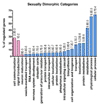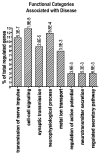Effects of gender on nigral gene expression and parkinson disease
- PMID: 17412603
- PMCID: PMC2435483
- DOI: 10.1016/j.nbd.2007.02.009
Effects of gender on nigral gene expression and parkinson disease
Abstract
To identify gene expression patterns in human dopamine (DA) neurons in the substantia nigra pars compacta (SNc) of male and female control and Parkinson disease (PD) patients, we harvested DA neurons from frozen SNc from 16 subjects (4 male PDs, 4 female PDs, 4 male and 4 female controls) using Laser Capture microdissection and microarrays. We assessed for enrichment of functional categories with a hypergeometric distribution. The data were validated with QPCR. We observed that gender has a pervasive effect on gene expression in DA neurons. Genes upregulated in females relative to males are mainly involved in signal transduction and neuronal maturation, while in males some of the upregulated genes (alpha-synuclein and PINK1) were previously implicated in the pathogenesis of PD. In females with PD we found alterations in genes with protein kinase activity, genes involved in proteolysis and WNT signaling pathway, while in males with PD there were alterations in protein-binding proteins and copper-binding proteins. Our data reveal broad gender-based differences in gene expression in human dopaminergic neurons of SNc that may underlie the predisposition of males to PD. Moreover, we show that gender influences the response to PD, suggesting that the nature of the disease and the response to treatment may be gender-dependent.
Figures




References
-
- Ascherio A, et al. Caffeine, postmenopausal estrogen, and risk of Parkinson’s disease. Neurology. 2003;60:790–5. - PubMed
-
- Baldereschi M, et al. Parkinson’s disease and parkinsonism in a longitudinal study: two-fold higher incidence in men. ILSA Working Group. Italian Longitudinal Study on Aging. Neurology. 2000;55:1358–63. - PubMed
-
- Barlow BK, et al. A fetal risk factor for Parkinson’s disease. Dev Neurosci. 2004;26:11–23. - PubMed
Publication types
MeSH terms
Substances
Grants and funding
LinkOut - more resources
Full Text Sources
Medical
Miscellaneous

